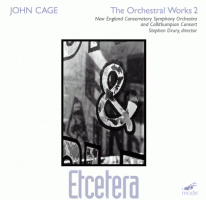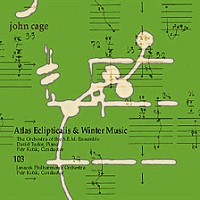Two new Cage recordings
|
Grant Chu Covell [November 2000. Originally appeared in La Folia 3:1.] John CAGE: Etcetera, Etcetera 2/4 Orchestras. Callithumpian Consort of New England Conservatory, Tamara Brooks, Stephen Drury, Charles Peltz (conds.); New England Conservatory Symphony Orchestra, Tamara Brooks, Marsha Hassett, Charles Peltz, Laurie K. Redmer (conds.). Mode 86. John CAGE: Atlas Eclipticalis with Winter Music, 103. Orchestra of the S.E.M. Ensemble, Kammerensemble Neue Musik Berlin, Janacek Philharmonic Orchestra, Petr Kotik (cond.); David Tudor (piano). Asphodel 2000. I was hoping to get my hands on the smartly priced 4-CD set from Asphodel in time for a long piece on David Tudor — and I did — but the performance of 103 is controversial and it’s more appropriate to talk of this set in context with Cage. So, the new Asphodel set gets to stand alongside a new release in Mode’s admirable ongoing Complete John Cage edition. Let’s get the names, numbers and people sorted out first (there will be a quiz): The Asphodel set (Asphodel 2000), contains two pieces, and each piece straddles two CDs for a total of 4CDs. The first piece is Atlas Eclipticalis with Winter Music which is really two works which Cage permitted to be played together. Atlas Eclipticalis is played by the Orchestra of the S.E.M. Ensemble with additional musicians from Kammerensemble Neue Musik Berlin all conducted by Petr Kotik, and Winter Music is played simultaneously by David Tudor at the piano. 103 is the second piece in the Asphodel set and it is played by the Janacek Philharmonic Orchestra in a controversial performance edition made by Kotik who also conducts. 103 is one of Cage’s “number pieces,” number pieces being the standard appellation for any of Cage’s late works that are named for the number of players performing. Different pieces for the same number of players are indicated with superscripts, thus Five2 is the second piece for five players (the typographic convention would also allow Five2). Along this scheme, if Beethoven’s only music for four players were his string quartets, then the last quartet would be called Four15, and the first Razumovsky, Four7. Mode 86 is a single CD and is the “Complete John Cage Edition Volume 21”, subtitled “The Orchestral Works 2”, and contains two works. The first work is Etcetera performed by the aptly named Callithumpian Consort of New England Conservatory with three conductors: Tamara Brooks, Stephen Drury and Charles Peltz. The second work is Etcetera 2/4 Orchestras performed by the New England Conservatory Symphony Orchestra with four conductors: Tamara Brooks, Marsha Hassett, Charles Peltz and Laurie K. Redmer. Both Etcetera and Etcetera 2/4 Orchestras contain tape parts of the environments in which Cage composed the pieces. The mode CD opens with Etcetera (20:44). Etcetera starts quietly with gentle tapping on cardboard boxes over the nature sounds on the accompanying tape. When the instruments appear they play short repetitious phrases. This performance is as good introduction as any to Cage’s environmental works, music which gently encourages the listener to take into account the listening environment alongside the musical activity (4:33 is perhaps the most infamous of such pieces). Etcetera 2/4 Orchestras (30:08) is much different, dating from 1986, 13 years after Etcetera of 1973. The orchestra is larger, and dense orchestral attacks cut through slower moving material. The accompanying tape part is of city noise from Cage’s apartment, and, though I have yet to hear it, the ringing of Cage’s telephone is captured on the tape. Recorded in Jordan Hall, Boston’s other great treasure of a concert hall (some would argue that it is a finer place than the B.S.O.’s Symphony Hall just across the street), this recording captures the energy of the performers and the unmatched liveliness and acoustics of the space. Atlas Eclipticalis with Winter Music (2:30:07 total; CD 1 is 76:55 and CD 2 is 73:12) is a large sprawling work that meanders through expanses of activity and silence. The piano part of Winter Music is all chords, some very wide, some with dense clusters, and it too contains grand swaths of activity and silence. Admittedly this is not an easily approachable Cage work: it seems formless and without purpose, and the sounds themselves are not intrinsically interesting or unique. Now what’s all the fuss about this recording of 103? Cage’s number pieces specify a range of time in which a player is to perform (these are called time brackets). For example, a performer might be instructed to start playing a note anywhere between 1:30 and 1:45 and finish anywhere between 1:50 and 2:15. In his controversial performance of 103, Kotik has predetermined the exact time when the player must start, though the player can determine when to end. This doesn’t seem like a big deal, but part of playing these works is that they will be different each time, and that performers must listen to one another and can react to what they are hearing. Kotik bases his interpretation of 103 upon his personal experience conducting and performing the music of Cage. A sabotaged performance of another Cage work that resulted in Cage’s anger prompted Kotik to exert more control in his subsequent performances of Cage’s work. I cannot fault Kotik for attempting 103 if he believes the result to be consistent with his understanding of Cage, and there the matter can rest, as we should all be allowed to interpret Cage in any way that is consistent and meaningful to us. But Kotik has essentially transformed 103 into 1 person playing all 103 parts. I doubt there would be interest in a synthesized performance of 103 made by one person. (But this could be a viable idea all on its own: Take 103 unique sounds, concrete or environmental, and arrange them using the parts of 103. Though this is something like Cage’s own 49 Waltzes for the 5 Boroughs). If we envision 103 as work where one-hundred and three individuals should convene to work together, whether democratically or even anarchically, then Kotik has done something very different indeed. The act of coming together to create the work is crucial to the work as a whole: the power and beauty of the work is in the mass of performers united by the common musical experience and goal, and this is a driving force in much of Cage’s music. Of course David Tudor created his own performance versions which he used whenever he performed any of Cage’s works, but these are his own versions for his own personal use. And though the community respects Tudor’s interpretations of Cage, Tudor would probably not have forced his interpretations upon others. I have been meandering through various recordings of other large and long number pieces to see if there is an audible difference, and I think there is. Compared to 58, 68 and 101, 103 is deficient. 101 (1989) is on Mode 41, “Complete John Cage Edition Volume 11: The Orchestral Works 1” and is a short 12:13 piece with a distinct shape: two loud bursts from brass and winds shatter a quiet yet gritty string background from which piano and harp float. 58 (1992) on hatART 6135 is for winds at 45:42 is a continuous dense texture where every pitch and shape contributes to the wonderful mass. 68 (1992) is 29:48 and is on hatART 6168 and is a magnificent piece of unisons a la Scelsi: only 15 pitches are played by each the entire ensemble. As each pitch moves past the colors change. Interestingly 58, 68 and 101 clearly have a form and a contour: the unisons of 68 sound unique to 68, the distinct choirs of 101 sound unique to 101. In comparison 103 is flaccid and lacks energy, almost passive, and at 1:23:49 is very long indeed (CD 1 is 34:55 and CD 2 is 59:54). In his notes, Kotik remarks that he spent four hours rehearsing 103, which I’m sure completely erased much of the chances for surprise and discovery for the players. Though at 38:46 on the second CD of 103, I hear a voice and not an instrument. Is this an anarchist trying to break through? One you start listening closely, it’s easy to hear that the strings choirs cycle through the same pitches. 103 is also not very colorful: standard techniques are used to make pitches and can’t hear anything other than bowed pitches from the strings. Kotik’s 103 also lacks the collective goal of it’s players: the performers of 103 do not share the same musical objectives as received from Cage as do the players of 58, 68 or 101 in my opinion and this is audible in the intensity of the performance. Sure the goal for the musicians in 103 is to play Cage’s 103 in Kotik’s arrangement, or play Kotik’s 103, but this is not the same goal that Cage would have set before them. Nonetheless, 103 is interesting, and Cage fans will have to pick it up to see what the fuss is about, but if you’re new to this aspect of Cage’s music, try the recordings of 58, 68 or 101 first.
[More Grant Chu Covell, Vol. 3, No. 1]
[More
Cage]
[Previous Article:
Scardanelli’s Motley]
[Next Article:
Piano Diary 1.]
|

